
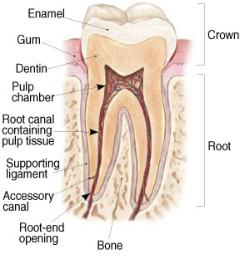
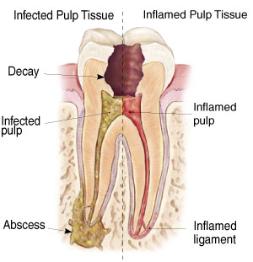
Healthy Tooth
Stages of Infections
Conventional Root Canal
Endodontic treatment is usually performed in one or two visits. The
endodontist examines and x-rays the tooth, then administers local
anesthetic. After the tooth is numb, the endodontist places a small
protective sheet called a "dental dam" is placed over the area to isolate
the tooth and keep it clean and free of saliva during the procedure. An
opening in the crown of the tooth is made in order to access and the
pulp is removed. Very small instruments are used to clean the pulp from
the pulp chamber and root canals and to shape the space for filling.
After the space is cleaned and shaped, the endodontist fills the root
canals with a biocompatible material called "gutta-percha." The
gutta-percha is placed with cement to ensure complete sealing of the
root canals. In most cases, a temporary filling is placed to close the
opening. The temporary filling will be removed by your dentist before the
tooth is restored.
Endodontic treatment is usually performed in one or two visits. The
endodontist examines and x-rays the tooth, then administers local
anesthetic. After the tooth is numb, the endodontist places a small
protective sheet called a "dental dam" is placed over the area to isolate
the tooth and keep it clean and free of saliva during the procedure. An
opening in the crown of the tooth is made in order to access and the
pulp is removed. Very small instruments are used to clean the pulp from
the pulp chamber and root canals and to shape the space for filling.
After the space is cleaned and shaped, the endodontist fills the root
canals with a biocompatible material called "gutta-percha." The
gutta-percha is placed with cement to ensure complete sealing of the
root canals. In most cases, a temporary filling is placed to close the
opening. The temporary filling will be removed by your dentist before the
tooth is restored.
What happens after treatment?
After the final visit with your endodontist, you must return to your dentist to have a crown or other
restoration placed on the tooth to protect and restore it to full function.
How much will it cost?
The cost varies depending on which tooth is affected. Most dental insurance policies provide some
coverage for endodontic treatment.
Generally, endodontic treatment and restoration of the natural tooth are less expensive than the
alternative of having the tooth extracted and replaced with a bridge or implant to restore chewing
function and prevent adjacent teeth from shifting. It is our goal to help you save your natural teeth with
root canal therapy.
After the final visit with your endodontist, you must return to your dentist to have a crown or other
restoration placed on the tooth to protect and restore it to full function.
How much will it cost?
The cost varies depending on which tooth is affected. Most dental insurance policies provide some
coverage for endodontic treatment.
Generally, endodontic treatment and restoration of the natural tooth are less expensive than the
alternative of having the tooth extracted and replaced with a bridge or implant to restore chewing
function and prevent adjacent teeth from shifting. It is our goal to help you save your natural teeth with
root canal therapy.
Surgical Root Canal
Although there are many surgical procedures that can be performed to save a tooth, the most common is called apicoectomy or root-end resection.
When inflammation or infection persists in the bony area around the end of your tooth after a root canal procedure, your endodontist may have to
perform an apicoectomy.
What is an Apicoectomy?
In this procedure, the endodontist opens the gum tissue near the tooth to see the underlying bone and to remove any inflamed or infected tissue.
The very end of the root is also removed. A small filling may be placed in the root to seal the end of the root canal, and a few stitches or sutures are
placed in the gingiva to help the tissue heal properly. Over a period of months, the bone heals around the end of the root.
Following the procedure, there may be some discomfort or slight swelling. This is normal for any surgical procedure. To alleviate any discomfort, an
appropriate pain medication will be recommended.
Although there are many surgical procedures that can be performed to save a tooth, the most common is called apicoectomy or root-end resection.
When inflammation or infection persists in the bony area around the end of your tooth after a root canal procedure, your endodontist may have to
perform an apicoectomy.
What is an Apicoectomy?
In this procedure, the endodontist opens the gum tissue near the tooth to see the underlying bone and to remove any inflamed or infected tissue.
The very end of the root is also removed. A small filling may be placed in the root to seal the end of the root canal, and a few stitches or sutures are
placed in the gingiva to help the tissue heal properly. Over a period of months, the bone heals around the end of the root.
Following the procedure, there may be some discomfort or slight swelling. This is normal for any surgical procedure. To alleviate any discomfort, an
appropriate pain medication will be recommended.
Retreatment:
With the appropriate care, your teeth that have had endodontic
treatment will last as long as other natural teeth. Yet, a tooth that has
received treatment may fail to heal or pain may continue to exist.
Sometimes, the pain may occur months or years after treatment. If so,
Endodontic Retreatment may be needed.
Once retreatment has been selected as a solution to your problem,
the doctors will reopen your tooth to gain access to the root canal
filling material. This restorative material will be removed to enable
access to the root canal. The doctors will now clean your canals and
carefully examine the inside of the problematic tooth. Once cleaned,
the doctors will fill and seal the canals and place a temporary filling in
the tooth.
At this point, you will need to return to your dentist as soon as
possible in order to have a new crown or restoration placed on the
tooth to restore full functionality.
A very small percentage of root canals are unsuccessful initially or fail
over time. Diseased tissue may be incompletely removed form the
roots originally or bacteria can slowly leak from new cavities, cracks,
loose fillings, crowns etc. past the root canal filling seal into the socket
bone. Fortunately, root canals can be retreated by removing the prior
filling materials, followed by cleaning and refilling the root canal
system. Posts placed over root canals can be ultrasonically vibrated
out if needed to allow for retreatment. Without retreatment,
endodontic therapy, a tooth is likely to require extraction.
With the appropriate care, your teeth that have had endodontic
treatment will last as long as other natural teeth. Yet, a tooth that has
received treatment may fail to heal or pain may continue to exist.
Sometimes, the pain may occur months or years after treatment. If so,
Endodontic Retreatment may be needed.
Once retreatment has been selected as a solution to your problem,
the doctors will reopen your tooth to gain access to the root canal
filling material. This restorative material will be removed to enable
access to the root canal. The doctors will now clean your canals and
carefully examine the inside of the problematic tooth. Once cleaned,
the doctors will fill and seal the canals and place a temporary filling in
the tooth.
At this point, you will need to return to your dentist as soon as
possible in order to have a new crown or restoration placed on the
tooth to restore full functionality.
A very small percentage of root canals are unsuccessful initially or fail
over time. Diseased tissue may be incompletely removed form the
roots originally or bacteria can slowly leak from new cavities, cracks,
loose fillings, crowns etc. past the root canal filling seal into the socket
bone. Fortunately, root canals can be retreated by removing the prior
filling materials, followed by cleaning and refilling the root canal
system. Posts placed over root canals can be ultrasonically vibrated
out if needed to allow for retreatment. Without retreatment,
endodontic therapy, a tooth is likely to require extraction.
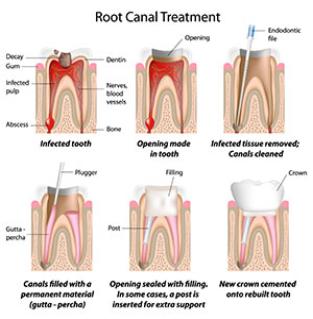
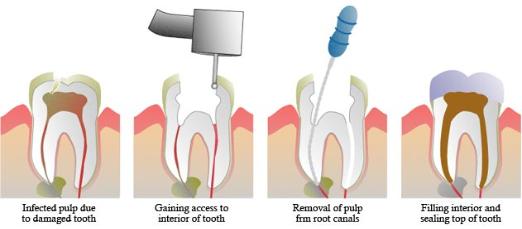
Improper healing may be caused by:
• Curved or narrow canals were not treated during the initial treatment.
• Canals that were not disinfected well enough during the initial procedure. This
does not necessarily indicate improper treatment, as some canals can exhibit
complex anatomy that can present challenges for sufficient cleaning.
• The crown or restoration was not placed within the appropriate amount of time
following the procedure.
• The crown or restoration did not prevent saliva from contaminating the inside
of the tooth.
In some cases, new problems can influence a tooth that was successfully treated:
• New decay can expose a root canal filling material, causing infection.
• A cracked or loose filling or crown can expose the tooth to new infection.
• Curved or narrow canals were not treated during the initial treatment.
• Canals that were not disinfected well enough during the initial procedure. This
does not necessarily indicate improper treatment, as some canals can exhibit
complex anatomy that can present challenges for sufficient cleaning.
• The crown or restoration was not placed within the appropriate amount of time
following the procedure.
• The crown or restoration did not prevent saliva from contaminating the inside
of the tooth.
In some cases, new problems can influence a tooth that was successfully treated:
• New decay can expose a root canal filling material, causing infection.
• A cracked or loose filling or crown can expose the tooth to new infection.
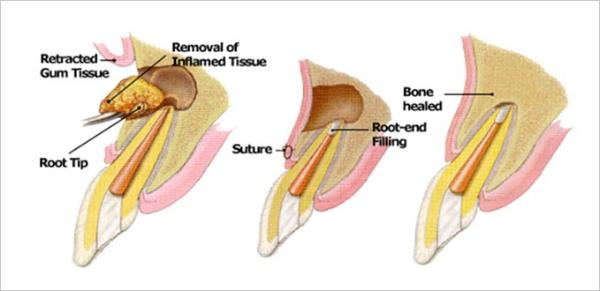

| GRANITE STATE ENDODONTICS Dr. Aneesa Al-Khalidi D.M.D 505 West Hollis Street ~ Suite 104 Nashua, NH 03062 603-883-3636 |